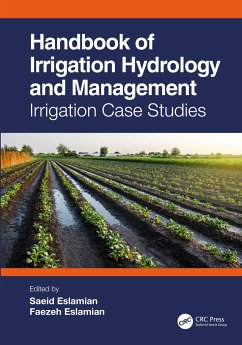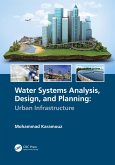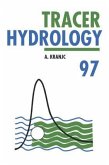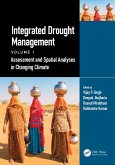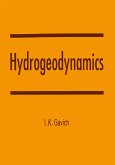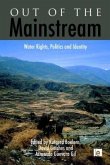Handbook of Irrigation Hydrology and Management
Irrigation Case Studies
Herausgeber: Eslamian, Saeid; Eslamian, Faezeh
Handbook of Irrigation Hydrology and Management
Irrigation Case Studies
Herausgeber: Eslamian, Saeid; Eslamian, Faezeh
- Gebundenes Buch
- Merkliste
- Auf die Merkliste
- Bewerten Bewerten
- Teilen
- Produkt teilen
- Produkterinnerung
- Produkterinnerung
The Handbook of Irrigation Hydrology and Management examines irrigated ecosystems in which water storage, applications, or drainage volumes are artificially controlled in the landscape and the spatial domain of processes varies from micrometers to tens of kilometers, while the temporal domain spans from seconds to centuries.
Andere Kunden interessierten sich auch für
![Water Systems Analysis, Design, and Planning Water Systems Analysis, Design, and Planning]() Mohammad KaramouzWater Systems Analysis, Design, and Planning191,99 €
Mohammad KaramouzWater Systems Analysis, Design, and Planning191,99 €![Tracer Hydrology 97 Tracer Hydrology 97]() A. Kranjc (ed.)Tracer Hydrology 97318,99 €
A. Kranjc (ed.)Tracer Hydrology 97318,99 €![Hydroinformatics Hydroinformatics]() Praveen KumarHydroinformatics296,99 €
Praveen KumarHydroinformatics296,99 €![Integrated Drought Management, Volume 2 Integrated Drought Management, Volume 2]() Integrated Drought Management, Volume 2254,99 €
Integrated Drought Management, Volume 2254,99 €![Integrated Drought Management, Volume 1 Integrated Drought Management, Volume 1]() Integrated Drought Management, Volume 1243,99 €
Integrated Drought Management, Volume 1243,99 €![Hydrogeodynamics Hydrogeodynamics]() I K GavichHydrogeodynamics344,99 €
I K GavichHydrogeodynamics344,99 €![Out of the Mainstream Out of the Mainstream]() Out of the Mainstream74,99 €
Out of the Mainstream74,99 €-
-
-
The Handbook of Irrigation Hydrology and Management examines irrigated ecosystems in which water storage, applications, or drainage volumes are artificially controlled in the landscape and the spatial domain of processes varies from micrometers to tens of kilometers, while the temporal domain spans from seconds to centuries.
Produktdetails
- Produktdetails
- Verlag: Taylor & Francis Ltd (Sales)
- Seitenzahl: 418
- Erscheinungstermin: 31. Mai 2023
- Englisch
- Abmessung: 254mm x 178mm x 24mm
- Gewicht: 971g
- ISBN-13: 9781032406077
- ISBN-10: 1032406070
- Artikelnr.: 67263635
- Verlag: Taylor & Francis Ltd (Sales)
- Seitenzahl: 418
- Erscheinungstermin: 31. Mai 2023
- Englisch
- Abmessung: 254mm x 178mm x 24mm
- Gewicht: 971g
- ISBN-13: 9781032406077
- ISBN-10: 1032406070
- Artikelnr.: 67263635
Dr. Saeid Eslamian is professor of Hydrology at Isfahan University of Technology, where he heads the Hydrology Research Group in the Department of Water Engineering. His research focuses mainly on statistical and environmental hydrology and climate change. In particular, he is working on modeling and prediction of natural hazards including flood, drought, storms, wind, groundwater drawdown, and pollution for arid and semi-arid zones, particularly in urban areas. He is also a Visiting Professor at Princeton University, and University of ETH Zurich, Switzerland. He has contributed to more than 300 publications in books, research journals, and technical reports or papers in conferences. He is the Founder and Editor-in-Chief of both the International Journal of Hydrology Science and Technology and the Journal of Flood Engineering. He received ASCE and EWRI awards in 2009 and 2010 for his research. Dr. Faezeh Eslamian current research focuses on the fate and transport of phosphorus through subsurface drained farmlands. Dr. Eslamian completed her PhD at McGill University, and her bachelor's and master's degrees in civil and environmental engineering from Isfahan University of Technology, Iran, where she evaluated natural and low-cost absorbents for the removal of pollutants such as textile dyes and heavy metals. Furthermore, she has conducted research on the worldwide water quality standards, wastewater reuse, and drought guidelines.
Part I: Australian Experiences. 1. Irrigation Developments in Australia:
Historical Development of Irrigation. 2. Irrigation Developments in
Australia: Irrigation and Agricultural Production. 3. Optimisation of
Twinged Stormwater Storage for Golf Course Irrigation: a Case Study in
Sydney. Part II: African Case Studies. 4. Deficit Irrigation: A Review from
Ethiopia. 5. Investigating the Working Hydraulic Conditions of Gezira two
Main Canals in Sudan. 6. Plant Water Requirements and Evapotranspiration.
7. Irrigation Practices in Moderately Warm Arid Areas of Sub-Sahara Africa.
8. Choosing the Proper Irrigation Technique in Temperate Semi-Arid Zones.
Part III: Chinese Irrigation History. 9. History of Irrigation in China:
Schedule and Method Development. 10. History of Irrigation in China:
Legislations and Farmer's Incentives. Part IV: American and Europe
Irrigation Developments. 11. Irrigation Water Use in the USA. 12.
Irrigation Developments in Brazil. 13. Irrigation Management in Romania.
Part V. Water Scarcity and Irrigation in India. 14. Water Resources and
Irrigation Practices of Contemporary India. 15. Water Scarcity in India-An
Evaluation prior to Independence. 16. Water Scarcity in India: Irrigation
Practices. Part VI: Middle East Irrigation and Deficit Irrigation. 17.
Middle East and Origin of Irrigation. 18. Deficit Irrigation and Partial
Root-Zone Drying Irrigation System in an Arid Area. 19. Paradigms Shaping
the Adoption of Irrigation Technologies in Ghana. 20. Over-Irrigation and
Adverse Effects in Aral Sea Basin.
Historical Development of Irrigation. 2. Irrigation Developments in
Australia: Irrigation and Agricultural Production. 3. Optimisation of
Twinged Stormwater Storage for Golf Course Irrigation: a Case Study in
Sydney. Part II: African Case Studies. 4. Deficit Irrigation: A Review from
Ethiopia. 5. Investigating the Working Hydraulic Conditions of Gezira two
Main Canals in Sudan. 6. Plant Water Requirements and Evapotranspiration.
7. Irrigation Practices in Moderately Warm Arid Areas of Sub-Sahara Africa.
8. Choosing the Proper Irrigation Technique in Temperate Semi-Arid Zones.
Part III: Chinese Irrigation History. 9. History of Irrigation in China:
Schedule and Method Development. 10. History of Irrigation in China:
Legislations and Farmer's Incentives. Part IV: American and Europe
Irrigation Developments. 11. Irrigation Water Use in the USA. 12.
Irrigation Developments in Brazil. 13. Irrigation Management in Romania.
Part V. Water Scarcity and Irrigation in India. 14. Water Resources and
Irrigation Practices of Contemporary India. 15. Water Scarcity in India-An
Evaluation prior to Independence. 16. Water Scarcity in India: Irrigation
Practices. Part VI: Middle East Irrigation and Deficit Irrigation. 17.
Middle East and Origin of Irrigation. 18. Deficit Irrigation and Partial
Root-Zone Drying Irrigation System in an Arid Area. 19. Paradigms Shaping
the Adoption of Irrigation Technologies in Ghana. 20. Over-Irrigation and
Adverse Effects in Aral Sea Basin.
Part I: Australian Experiences. 1. Irrigation Developments in Australia:
Historical Development of Irrigation. 2. Irrigation Developments in
Australia: Irrigation and Agricultural Production. 3. Optimisation of
Twinged Stormwater Storage for Golf Course Irrigation: a Case Study in
Sydney. Part II: African Case Studies. 4. Deficit Irrigation: A Review from
Ethiopia. 5. Investigating the Working Hydraulic Conditions of Gezira two
Main Canals in Sudan. 6. Plant Water Requirements and Evapotranspiration.
7. Irrigation Practices in Moderately Warm Arid Areas of Sub-Sahara Africa.
8. Choosing the Proper Irrigation Technique in Temperate Semi-Arid Zones.
Part III: Chinese Irrigation History. 9. History of Irrigation in China:
Schedule and Method Development. 10. History of Irrigation in China:
Legislations and Farmer's Incentives. Part IV: American and Europe
Irrigation Developments. 11. Irrigation Water Use in the USA. 12.
Irrigation Developments in Brazil. 13. Irrigation Management in Romania.
Part V. Water Scarcity and Irrigation in India. 14. Water Resources and
Irrigation Practices of Contemporary India. 15. Water Scarcity in India-An
Evaluation prior to Independence. 16. Water Scarcity in India: Irrigation
Practices. Part VI: Middle East Irrigation and Deficit Irrigation. 17.
Middle East and Origin of Irrigation. 18. Deficit Irrigation and Partial
Root-Zone Drying Irrigation System in an Arid Area. 19. Paradigms Shaping
the Adoption of Irrigation Technologies in Ghana. 20. Over-Irrigation and
Adverse Effects in Aral Sea Basin.
Historical Development of Irrigation. 2. Irrigation Developments in
Australia: Irrigation and Agricultural Production. 3. Optimisation of
Twinged Stormwater Storage for Golf Course Irrigation: a Case Study in
Sydney. Part II: African Case Studies. 4. Deficit Irrigation: A Review from
Ethiopia. 5. Investigating the Working Hydraulic Conditions of Gezira two
Main Canals in Sudan. 6. Plant Water Requirements and Evapotranspiration.
7. Irrigation Practices in Moderately Warm Arid Areas of Sub-Sahara Africa.
8. Choosing the Proper Irrigation Technique in Temperate Semi-Arid Zones.
Part III: Chinese Irrigation History. 9. History of Irrigation in China:
Schedule and Method Development. 10. History of Irrigation in China:
Legislations and Farmer's Incentives. Part IV: American and Europe
Irrigation Developments. 11. Irrigation Water Use in the USA. 12.
Irrigation Developments in Brazil. 13. Irrigation Management in Romania.
Part V. Water Scarcity and Irrigation in India. 14. Water Resources and
Irrigation Practices of Contemporary India. 15. Water Scarcity in India-An
Evaluation prior to Independence. 16. Water Scarcity in India: Irrigation
Practices. Part VI: Middle East Irrigation and Deficit Irrigation. 17.
Middle East and Origin of Irrigation. 18. Deficit Irrigation and Partial
Root-Zone Drying Irrigation System in an Arid Area. 19. Paradigms Shaping
the Adoption of Irrigation Technologies in Ghana. 20. Over-Irrigation and
Adverse Effects in Aral Sea Basin.

